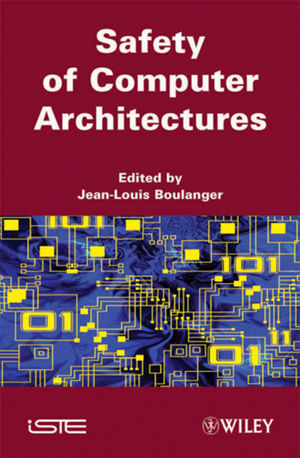Safety of Computer ArchitecturesISBN: 978-1-84821-197-1
Hardcover
512 pages
August 2010, Wiley-ISTE
 |
||||||
Introduction xiii
Chapter 1. Principles 1
Jean-Louis BOULANGER
1.1. Introduction 1
1.2. Presentation of the basic concepts: faults, errors and failures 1
1.3. Safe and/or available architecture 7
1.4. Resetting a processing unit 7
1.5. Overview of safety techniques 8
1.6. Conclusion 45
1.7. Bibliography 45
Chapter 2. Railway Safety Architecture 47
Jean-Louis BOULANGER
2.1. Introduction 47
2.2. Coded secure processor 47
2.3. Other applications 53
2.4. Regulatory and normative context 60
2.5. Conclusion 66
2.6. Bibliography 66
Chapter 3. From the Coded Uniprocessor to 2oo3 69
Gilles LEGOFF and Christophe GIRARD
3.1. Introduction 69
3.2. From the uniprocessor to the dual processor with voter 71
3.3. CSD: available safety computer 80
3.4. DIVA evolutions 93
3.5. New needs and possible solutions 99
3.6. Conclusion 101
3.7. Assessment of installations 102
3.8. Bibliography 103
Chapter 4. Designing a Computerized Interlocking Module: a
Key Component of Computer-Based Signal Boxes Designed by the SNCF
105
Marc ANTONI
4.1. Introduction 105
4.2. Issues 107
4.3. Railway safety: fundamental notions 116
4.4. Development of the computerized interlocking module 124
4.5. Conclusion 145
4.6. Bibliography 147
Chapter 5. Command Control of Railway Signaling Safety:
Safety at Lower Cost 149
Daniel DRAGO
5.1. Introduction 149
5.2. A safety coffee machine 149
5.3. History of the PIPC 150
5.4. The concept basis 155
5.5. Postulates for safety requirements 157
5.6. Description of the PIPC architecture7 159
5.7. Description of availability principles 173
5.8. Software architecture 176
5.9. Protection against causes of common failure 186
5.10. Probabilistic modeling 188
5.11. Summary of safety concepts 194
5.12. Conclusion 197
5.13. Bibliography 198
Chapter 6. Dependable Avionics Architectures: Example of a
Fly-by-Wire system 199
Pascal TRAVERSE, Christine BEZARD, Jean-Michel CAMUS, Isabelle
LACAZE, Hervé LEBERRE, Patrick RINGEARD and Jean SOUYRIS
6.1. Introduction 199
6.2. System breakdowns due to physical failures 205
6.3. Manufacturing and design errors 215
6.4. Specific risks 223
6.5. Human factors in the development of flight controls 225
6.6. Conclusion 229
6.7. Bibliography 229
Chapter 7. Space Applications 233
Jean-Paul BLANQUART and Philippe MIRAMONT
7.1. Introduction 233
7.2. Space system 233
7.3. Context and statutory obligation 237
7.4. Specific needs 243
7.5. Launchers: the Ariane 5 example 252
7.6. Satellite architecture 281
7.7. Orbital transport: ATV example 292
7.8. Summary and conclusions 302
7.9. Bibliography 304
Chapter 8. Methods and Calculations Relative to “Safety
Instrumented Systems” at TOTAL 307
Yassine CHAABI and Jean-Pierre SIGNORET
8.1. Introduction 307
8.2. Specific problems to be taken into account 308
8.3. Example 1: system in 2/3 modeled by fault trees 322
8.4. Example 2: 2/3 system modeled by the stochastic Petri net 328
8.5. Other considerations regarding HIPS 333
8.6. Conclusion 342
8.7. Bibliography 343
Chapter 9. Securing Automobile Architectures 345
David LIAIGRE
9.1. Context 345
9.2. More environmentally-friendly vehicles involving more embedded electronics 347
9.3. Mastering the complexity of electronic systems 348
9.4. Security concepts in the automotive field 350
9.5. Which security concepts for which security levels of the ISO 26262 standard? 364
9.6. Conclusion 376
9.7. Bibliography 377
Chapter 10. SIS in Industry 379
Grégory BUCHHEIT and Olaf MALASSE
10.1. Introduction 379
10.2. Safety loop structure 384
10.3. Constraints and requirements of the application 407
10.4. Analysis of a safety loop 413
10.5. Conclusion 423
10.6. Bibliography 424
Chapter 11. A High-Availability Safety Computer 425
Sylvain BARO
11.1. Introduction 425
11.2. Safety computer 426
11.3. Applicative redundancy 433
11.4. Integrated redundancy 433
11.5. Conclusion 443
11.6. Bibliography 446
Chapter 12. Safety System for the Protection of Personnel in
the CERN Large Hadron Collider 447
Pierre NININ, Silvia GRAU, Tomasz LADZINSKI and Francesco
VALENTINI
12.1. Introduction 447
12.2. LACS 450
12.3. LASS 452
12.4. Functional safety methodology 459
12.5. Test strategy 466
12.6. Feedback 472
12.7. Conclusions 473
12.8. Bibliography 474
Glossary 477
List of Authors 485
Index 487



